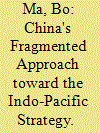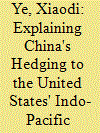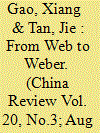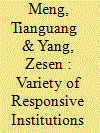|
|
|
Sort Order |
|
|
|
Items / Page
|
|
|
|
|
|
|
| Srl | Item |
| 1 |
ID:
174404


|
|
|
|
|
| Summary/Abstract |
Since the Trump administration endorsed the concept of Indo-Pacific in 2017 and later rolled out a US Indo-Pacific strategy, the Chinese government and China's academic and policy community have maintained a high interest in understanding the strategy in terms of its conception and substance. However, Chinese officials and scholars have been divided in assessing the nature, purposes, and impacts of the strategy and have reached no consensus on policy responses. This fragmentation has appeared before, as we have seen among international law scholars on some thorny international law issues. This article argues that the larger the scale of the issue, the higher the degree of fragmentation is likely to be in China's policy and academic community. The US Indo-Pacific strategy is a good example of that parallel and vertical fragmentation. Chinese scholars, coming from different academic backgrounds, have offered different assessments and recommendations on the Indo-Pacific strategy, which have made the policy debate in today's China quite vibrant and sophisticated.
|
|
|
|
|
|
|
|
|
|
|
|
|
|
|
|
| 2 |
ID:
174399


|
|
|
|
|
| Summary/Abstract |
Using Hong Kong and Shenzhen in a comparative case study, this article addresses two important questions about digital governance: what its development sequence is, and the governance role of social media in the Chinese context. A content analysis is performed of social media communication by four sets of comparable agencies in the two cities, using the framework of e-government interconnectivity. Contrary to general expectations, our findings show that Shenzhen was more active than Hong Kong in the governmental use of social media. The results also suggest that, against the normative and sequential models, there is no strict sequence or particular order of development that must be followed in digital governance, thus rejecting the stage-by-stage "walk before you run" hypothesis. A government can "leapfrog" or "run before it walks" in its digital governance, bypassing earlier stages of development. Furthermore, the study shows that digital governance is an important tool of institutional adaptation and development to enhance a government's ability to respond to a dynamic environment of raising citizen expectations. State-led digitalization complements and compensates for the traditional and formal citizen–government interaction mechanisms, making offline and online institutions interchangeable and substitutable, and therefore also more interrelated and indistinguishable.
|
|
|
|
|
|
|
|
|
|
|
|
|
|
|
|
| 3 |
ID:
174405


|
|
|
|
|
| Summary/Abstract |
How China responds to the United States' Indo-Pacific strategy has become a crucial question for both policymakers and academics. The existing literature primarily focuses on how and why the United States, Japan, Australia, and India have promoted the Indo-Pacific concept and how this concept has imposed strategic pressure on China's national security. However, China's changing and complex attitudes and strategic responses to the Indo-Pacific concept have largely been overlooked. This article analyzes China's response from the perspective of a hedging strategy. It argues that while confronting the expanding range of containment, which is the crux of the Indo-Pacific strategy, China has applied a hedging strategy from two interrelated perspectives. In responding to the United States, the Chinese government adheres to the nonalliance principle and upgrades its China-Russia strategic partnership to resist the security pressure produced by the Indo-Pacific strategy. In responding to peripheral countries, China has adopted a reassurance approach to create a cooperative incentive for peripheral countries, particularly those that have security relations with the United States.
|
|
|
|
|
|
|
|
|
|
|
|
|
|
|
|
| 4 |
ID:
174401


|
|
|
|
|
| Summary/Abstract |
It is widely believed that fiscal transparency by means of information and communication technologies (ICTs) will ensure public trust in the digitalization era. However, there is little empirical knowledge about the effects of such online fiscal transparency practices, and why they should occur, in non-Western countries. We investigate the empirical relationship between fiscal transparency online and public trust by undertaking a trace processing case study on the Baimiao township government from Sichuan province in mainland China. The findings reveal that fiscal transparency online may result in better public trust in China. However, improvement in stakeholders' trust depends on the local development leapfrogging rather than political accountability. Moreover, the use of ICTs plays a vital role in attracting and inspiring multiple stakeholders during this process to mitigate the intense state-society relations. Correspondingly, governmental performance might be improved dramatically if government's capacity for resource mobilization and people's sense of gain can be enhanced to make successful use of ICTs and image building online. This paper contributes to the literature through the finding that ICTs can be used to mitigate the statesociety relations regarding the impact of fiscal transparency on public trust in China in the digital governance era.
|
|
|
|
|
|
|
|
|
|
|
|
|
|
|
|
| 5 |
ID:
174400


|
|
|
|
|
| Summary/Abstract |
This article argues that the state-society relations in China's digital era are shaped not only by the communication between the citizens and governments but also by the interactions among different levels of governments. Without formal power to keep the government in check, citizens may gain a louder voice through ICTs, yet exert a limited impact on policymaking. Based on a review of policy documents and an in-depth case study of the "One-Go at Most" reform in Zhejiang province, this research argues that the intervention of upper-level governments changes how the citizens and governments interact at the local level. First, the provincial party-government conducts online citizen surveys to collect information on the local governments, aiming to ensure the full implementation of the reform agenda. This strategy also equips the citizens with informal power, which forces the municipal and county governments to be more responsive and accountable with regard to efficient service delivery. Second, the provincial government has initiated the virtual government program to consolidate the new administrative procedures and standards into the cage of codes. This digitalized iron cage constrains the local cadres' discretion and establishes an e-monitoring system. The case of "One-Go at Most" in Zhejiang province provides a vivid example of how top-down mobilized digitalization can lead to a Weberian administrative system that is rational, routinized, and impartial. It is worth noting that the digital iron cage mainly exerts constraints on the administrative system. Stateled digitalization does not lead to formal power sharing between the state and society. This article concludes that the digital Weberian bureaucracy leads to the consolidation of the state's infrastructure power, and the question of whether or not this will facilitate the state's despotic power requires further exploration.
|
|
|
|
|
|
|
|
|
|
|
|
|
|
|
|
| 6 |
ID:
174407


|
|
|
|
|
| Summary/Abstract |
Can China turn away from using Hong Kong as its main international financial center (IFC)? This article offers a framework with an international political economy (IPE) perspective that draws on pioneering IPE research into China's growing global financial presence and monetary influence, through which an assessment is made of Hong Kong's future as a financial center in relation to the Chinese mainland. Although the social unrest in the city from the mid-2010s onward has prompted Beijing to look for alternative financial hubs in the region, Hong Kong's contributions have been hard to replace, and that will likely remain the case for the foreseeable future. The analysis concludes by outlining two potential future scenarios for Hong Kong.
|
|
|
|
|
|
|
|
|
|
|
|
|
|
|
|
| 7 |
ID:
174406


|
|
|
|
|
| Summary/Abstract |
The Trump administration has fleshed out a novel approach called the Indo-Pacific strategy to address the China challenge in the 21st century. Although it is still debatable about the content, aims, and approaches of the US Indo-Pacific strategy, it is crystal clear that China has taken the US Indo-Pacific strategy seriously. Students of international relations have attempted to better understand China's response to the US Indo-Pacific strategy. In this article, I propose a new perspective to comprehend China's strategic and more importantly preemptive response to the US Indo-Pacific strategy, which I call a niche strategy. The niche strategy is a widely discussed marketing strategy in the business and marketing communities. Inspired by the burgeoning marketing studies on niche strategy, this article attempts to conceptualize it in international relations as a vital foreign policy strategy and then to apply it to understand and explain China's strategic response to the US Indo-Pacific strategy. Exemplified and emboldened by the operation of the Asian Infrastructure Investment Bank (AIIB) and the changing orientations of the Belt and Road Initiative (BRI), China's niche strategy can help the country better navigate the pressure from the US Indo-Pacific strategy. However, it still remains a question whether the clash of China's niche strategy and the US Indo-Pacific strategy will lead to war or peace.
|
|
|
|
|
|
|
|
|
|
|
|
|
|
|
|
| 8 |
ID:
174397


|
|
|
|
|
| Summary/Abstract |
This article provides an overview of research on digitalization and how it affects state-society relations in China and around the world. It offers a necessary background for understanding the Chinese government's incorporation of digital technology into public administration and how digitalization impacts state-society relations, which is a central theme of this special issue. We find that the Chinese government's proactive use of digital technology has given rise to the complex interaction between the citizens and agencies in a fragmented state system. While censorship and propaganda are still important functions of information and communication technologies (ICTs), we also find that different parts of the state adopt ICTs for various other purposes, and the use of ICTs results in multiple consequences. Higher-level governments aim to use an "e-Weberian" system to keep their subordinates in check, while some local governments seek to attract investment by leapfrogging in digitalization. Empirical evidence suggests that the quality of online responsiveness also varies across agencies and regions. We conclude that the process and outcomes of digitalization are shaped not only by the interaction between the citizens and government but also by the competition, strategizing, and collaboration among state actors.
|
|
|
|
|
|
|
|
|
|
|
|
|
|
|
|
| 9 |
ID:
174402


|
|
|
|
|
| Summary/Abstract |
China is and will remain the most important great-power rival for the United States in the 21st century. The Trump administration has adopted a whole-of-government approach to compete with China. Washington is taking tough measures confronting China's challenges to the US economic interests, values, and security. The Indo-Pacific region is a key area where US-China strategic competition takes place. The US Indo-Pacific Strategy (IPS) is a core competitive instrument for Washington to contain China's rising power and influence among those countries along the Indian and Pacific Oceans. The articles in this special section examine the changing parameters of the US-China relationship and how Beijing responds to the US Indo-Pacific Strategy.
|
|
|
|
|
|
|
|
|
|
|
|
|
|
|
|
| 10 |
ID:
174403


|
|
|
|
|
| Summary/Abstract |
The US-China relationship defines geopolitics in the 21st century. Despite a messy start, the Trump administration was able to provide a new national security strategy within the first year in office. The new US national security strategy clearly defines China as a strategic rival that "challenges American power, influence, and interests, attempting to erode American security and prosperity." For the first time, the United States outlined an Indo-Pacific strategy to compete with and contain China's rising power and influence among those countries along the Indian and Pacific oceans. As part of an overall competitive strategy vis-à-vis China, US Secretary of State Mike Pompeo called for "a new alliance of democracies" against China in the international community. The Chinese government has yet to officially respond to the US Indo-Pacific strategy as well as the "free and open Indo-Pacific" concept. Ten years ago, when the Obama administration rolled out the "pivot to Asia" strategy, Beijing's answer was a grand geoeconomic plan to expand Chinese economic power along the ancient Silk Roads on land and sea. Ten years later, how will Beijing respond to the new strategic challenge from Washington? In this article, the authors argue that Beijing has not taken tit-for-tat action to respond to the US Indo-Pacific Strategy. Instead, China has responded to the new American challenge in a more constructive, peaceful, and nonconfrontational manner. Beijing's objective is to mitigate possible national security risks while continuing to extend its international influence in the Indo-Pacific region and beyond.
|
|
|
|
|
|
|
|
|
|
|
|
|
|
|
|
| 11 |
ID:
174398


|
|
|
|
|
| Summary/Abstract |
The widespread use of the ICTs (information and communication technologies) has reshaped the state-society relations and is driving the diffusion of digital responsiveness, which is serving as a channel to link public opinions and policymaking. A growing body of literature focuses on how the Chinese government responds to the public in cyberspace. However, how responsive institutions are shaping the quality of responsiveness is underdiscussed. We explore a variety of responsive institutions in subnational China and examine their effect on response quality through automated text analyses to massive citizen-government interactive records. There exist six parallel typologies of responsive institutions, including party office, government office, inclusive agency, functional agency, supervision agency, and petition office. Compared with the others, party and government office, professional functional agencies are more likely to stimulate the improvement of response quality. Agencies with limited political authority often fail to make a highquality response. The degree of institutionalization does not improve response quality but facilitates response timeliness. Local leaders' demonstration behavior, however, counteractively has a positive effect on response quality.
|
|
|
|
|
|
|
|
|
|
|
|
|
|
|
|
|
|
|
|
|